Mastering the Art of Prime Rib Roast Preparation
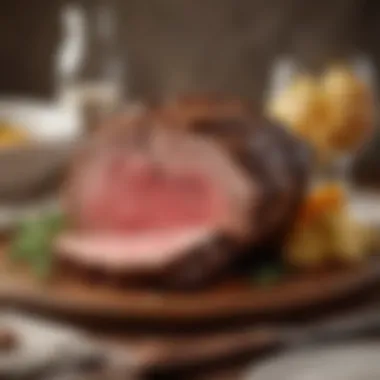
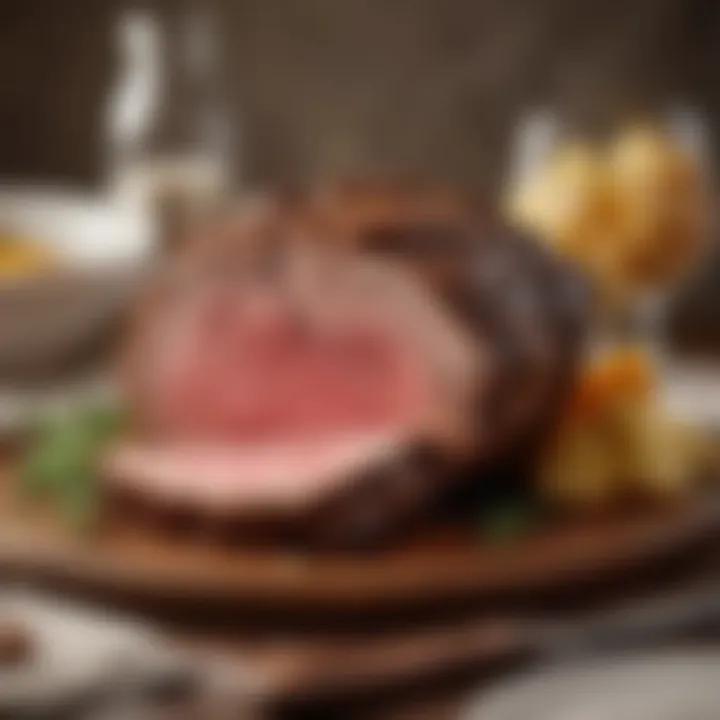
Recipe Overview
Title: The Art of Prime Rib
Yield: Serves 6 to 8
Prep Time: 20 minutes
Cook Time: 2 to 3 hours
Difficulty: Medium
Main Ingredients
- Prime rib roast (bone-in is preferred)
- Salt (kosher, coarse)
- Black pepper (freshly ground)
- Garlic (freshly minced)
- Fresh rosemary
- Olive oil
Preparing the perfect prime rib roast involves various technique and patience, making it a favorite for festive gatherings and special occasions. The rich marbling of a prime rib contributes not only to its flavor but also to its tenderness when cooked correctly. Therefore, understanding how to handle these steaks is essential for producing a dish that delights the palates of you and your guests.
Step-by-Step Instructions
To begin, selection of meat is vital. Choose a well-marbled prime rib with good color. Understanding optimal cuts can help immensely in achieving an outstanding roast flavor and texture.
Ingredient Preparation
- Bringing to Room Temperature: Allow the prime rib roast to sit out for about one hour before cooking. This step helps ensure even cooking.
- Season Generously: Pat the roast dry with paper towels, a necessary step for the seasoning mix. Rub salt and black pepper generously on all sides of the meat. Follow with minced garlic and fresh rosemary.
- Olive Oil Application: Drizzle the roast lightly with olive oil before seasoning. This will help fuse the flavors while roasting.
Cooking the Roast
- Preheat the Oven: Set the oven to 450°F (232°C) to prime the cooking environment for crispy results.
- Initial High-Heat Phase: Place the roast in the oven and cook for 20 to 30 minutes at this high temperature, helping the beef develop a rich crust.
- Lower the temperature: After the initial phase, reduce the oven temperature to 325°F (163°C) and continue cooking. Cooking times can vary, generally requiring 15-20 minutes per pound for medium-rare. Use a meat thermometer to confirm doneness, aiming for 130-135°F (54-57°C).
- Resting Period: Allow the roast to rest for 20 minutes after removing it from the oven before carving. This enables juices to redistribute throughout the meat.
Time-saving Tips
- Meat Thermometer: An indispensable tool that ensures doneness with precision—avoid guessing this and make use of a quality meat thermometer.
- Prep Ahead: This roast can have its seasonings applied the night prior, wrapped tightly in plastic wrap. It enhances flavors dramatically.
Nutritional Information
Estimating the number of calories utilized can be important for those tracking their intake:
- Calories: Approx. 300 per portion
- Macros:
- Protein: 29g
- Fat: 21g
- Carbohydrates: 0g
Also, prime rib is a great source of vitamins and minerals beneficial for health, including ample iron, zinc, and Vitamin B12.
Quick Cooking Tips
- Utilize kitchen gadgets, such as a slow cooker, especially if you have a busy schedule. However, slow roasting in an oven maximizes flavor integrity.
- It is possible to multitask effectively by prepping sides during the roast’s resting phase. Think of roast vegetables or managing a salad on the side.
- Consider healthful alternatives, like using a rub of smoked paprika instead of oil for less fat content while achieving flavorful depth.
Related Recipes & Variations
Complement your prime rib with SEMILRY
- Raddicchio Salad—crunchy and refreshing
- Garlic Mashed Potatoes to absorption
- Horseradish Sauce adds a spicy zing.
Remind readers, dietary variations like roasting cauliflower stakes instead of meat are acceptable.
Each cook can share their variations of flavor profile explorations, ever-evolving creativity will open new festive meals.
Understanding Prime Rib
Understanding prime rib is crucial for any culinary enthusiast aiming to master this exquisite cut of beef. This section will serve as the foundation upon which a successful preparation begins. Knowing what prime rib is, along with familiarizing oneself with its various cuts, can significantly enhance the overall cooking experience, flavor profile, and ultimately the dining satisfaction of the meal.
When selecting and preparing a prime rib roast, both the qualities and characteristics of the meat play a substantial role. This can affect cooking techniques and the final presentation on the plate. A well-informed selection enhances the potential taste, ensuring that the roast meets not just expectations but truly impresses. Evaluating aspects like marbling, tenderness, and cut is essential to securing the best experience.
What is Prime Rib?
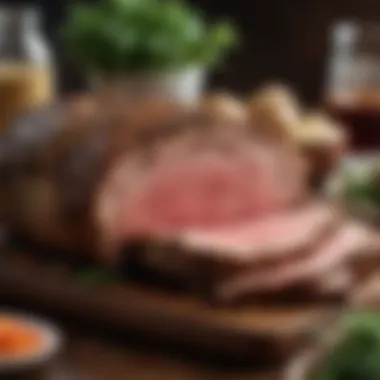

Prime rib is a classic cut of beef, renowned for its rich flavor and tenderness. It comes from the primal rib section of the cow, typically encompassing ribs six through twelve. This region is known for the prime rib roast’s marbled texture, which allows for a more succulent bite when cooked. The term 'prime' often denotes both the USDA grading system and the culinary allure of this specific cut.
While typically roasted as a whole piece, prime rib can be served as either a bone-in or boneless cut, with the bone enhancing the broth flavor during the cooking process. The slice retains a tenderness that can stand out compared to other cuts of beef, making it a preferred choice for both special occasions and regular family gatherings.
Prime rib is celebrated for its flavorsome and juicy meat, an essential choice for those who appreciate high-quality beef.
Different Cuts of Prime Rib
Within the realm of prime rib, there are notable distinctions between various cuts, each offering unique taste profiles and cooking requirements. The primary cuts of prime rib include:
- Prime Rib Roast: The complete roast, typically between four to seven pounds, featuring ample fat and marbling.
- Standing Rib Roast: This cut includes the bone and is frequently presented for its dramatic appearance. It retains more flavor preserving the bones during cooking.
- Ribeye Roast: A richer cut that is boneless. It emphasizes the marbled texture, popular for smaller gatherings where slicing allows for a more manageable serving.
By understanding these cuts, one can make informed decisions according to personal preferences and preparation time. Each has its own characteristics, requiring varied approaches to cooking for optimal results.
Selecting the Right Prime Rib
When venturing into the culinary art of making prime rib, selecting the right cut of meat is crucial. This section aims to explain why proper selection influences both the flavor and tenderness of the roast. A prime rib roast not only acts as the centerpiece of the meal but also defines the dining experience. Choosing well can minimize preparation hassles and elevate the outcome, gratifying all involved.
Factors to Consider When Choosing Meat
Choosing the ideal prime rib involves several factors that influence the eventual taste and texture. Here are the main elements to keep in mind:
- Cut Type: Primarily, prime rib comes from the rib section, known for its rich marbling and flavor. Look for a well-marbled cut, indicating that it will likely cook well and remain juicy.
- Weight: Understand your serving needs by considering the roast’s weight. Generally, estimate about one pound per person, but heavier cuts allow for more leftovers or presentation opportunities.
- Bone-In vs. Boneless: Bone-in cuts can provide extra flavor during cooking, as bones contribute to the moisture and richness of the roast. However, boneless cuts are easier to carve.
- Freshness: Freshness is a key consideration. Prefer a bright-colored meat without any off-putting odor. It should feel moist but not slick because excess moisture can indicate spoilage.
By balancing these factors, you can confidently select a cut that not only satisfies your expectations but also impresses your guests.
Understanding Grades of Beef
Knowing beef grades plays a pivotal role in understanding the quality of the prime rib available in the market. The USDA categorizes beef into various grades, which reflect the tenderness, juiciness, and flavor.
- Prime: This is the highest grade offered, recognized by abundant marbling. Prime cuts are typically restaurant-standard and are usually not easily found in most grocery stores.
- Choice: The second-best quality, choice meats tend to be less marbled than prime but remain flavorful and tender. Most consumers find this to be a good balance between quality and cost.
- Select: This grade has less marbling and is usually tougher than the higher grades. While still viable for roasting, the results may not amaze unless proper cooking techniques are applied.
- Quality Labels: Simple terms about the origins help too. Grass-fed and grain-fed beef refers to the animal's diet, and these factors can indeed alter the meat’s overall flavor and texture.
In summary, making educated decisions around beef grades and understanding factors affecting selection not only enhances the cooking process of prime rib but ensures a rewarding experience around the dining table. Leveraging this knowledge will serve the culinary enthusiast well.
Essential Preparation Techniques
Essential preparation techniques play a pivotal role in achieving an exquisite prime rib roast. Proper preparation sets the stage for a delectable final outcome. These steps ensure the meat is not only flavored well but also cooked evenly, enhancing each bite. The benefits of effective preparation go beyond taste. They also influence texture and juiciness. Consider these elements carefully to maximize the impact of your roast.
Thawing and Bringing to Room Temperature
Thawing the prime rib in the refrigerator is highly recommended. This method lets the meat defrost gradually, preserving texture and preventing bacterial growth. Ideally, allow one day for every four pounds of meat. Once thawed, the next crucial step is to allow the roast to come to room temperature. It is better if the prime rib sits out for at least one hour before cooking. This step helps in cooking the meat more evenly. By ensuring a consistent temperature, you reduce the chance of cold spots that may lead to that undercooked and overcooked combination.
Trimming and Seasoning the Meat
Trim the prime rib with care. Removing excess fat cap enhances the flavor concentration. Fat adds flavor but must be equalized for proper cooking. Trim away any silverskin, as it can make the meat tough. Once administered, seasoning does wonders for taste. A simple mixture of kosher salt and freshly cracked black pepper is ideal. Season generously, covering all sides of the roast. This salt will fine-tune flavors during the resting phase after cooking. If desired, let the meat marinate for a few hours to deepen the flavor profile.
Setting Up Your Cooking Environment
Properly setting up your cooking environment is absolutely essential. Make sure you have all necessary tools ready: a roasting pan, meat thermometer, and carving knife. Preheat the oven at proper temperature according to the chosen method. Enjoying efficient work in a clean, organized kitchen leads to better results.
A hot oven allows for searing. For smaller cooking devices, such as a sous vide or a grill, run tests to adjust temperatures before fully cooking your prime rib. Gather all your ingredients beforehand, ensuring a smooth process.
Getting the essentials in place makes all the difference for skillful cooking and ensures each meal becomes a personal triumph.
Cooking Methods for Prime Rib
Understanding the different cooking methods for prime rib is vital as it greatly affects the flavor, texture, and overall quality of the roast. Each method brings its own unique characteristics and can cater to varied tastes and preferences. Evaluating the pros and cons of each technique not only enhances your culinary skills but also optimizes your dining experience. Here, we’ll delve into three popular methods: roasting in the oven, using a sous vide method, and grilling the prime rib.
Roasting in the Oven
Roasting is perhaps the most traditional method for preparing prime rib. This technique involves cooking the meat in an oven at a consistent temperature, allowing it to roast evenly while maintaining a juicy interior.
Advantages of Ovven Roasting:
- Flavor Development: The dry heat enhances the rich flavors of the beef, helping develop a beautiful crust.
- Consistent Cooking: An oven provides stable heat, reducing the risk of uneven cooking.
- Convenience: Once prepared, the meat can roast unattended, freeing you to focus on other cooking tasks or side dishes.
Key Considerations:
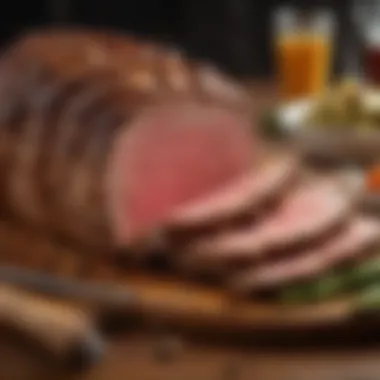
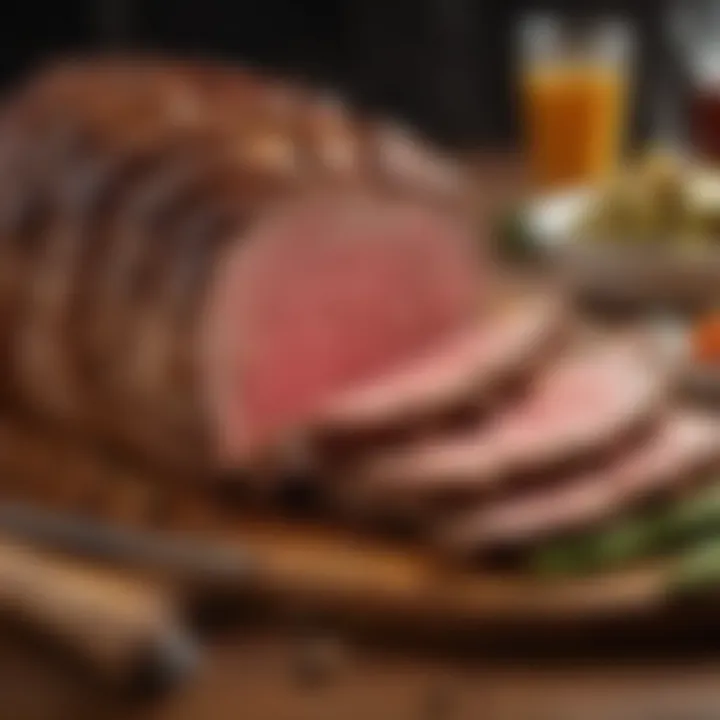
Planning is crucial when it comes to oven roasting.
- Preheating: Always preheat the oven to ensure even cooking from the start.
- Using a Meat Thermometer: To avoid overcooking, invest in a reliable meat thermometer. The sought-after mid-range doneness for prime rib is around 130°F.
- Resting Time: After pulling the pinnacle roast from the oven, allow it to rest. This step ensures that juices redistribute throughout the meat, yielding a more flavorful outcome.
Using a Sous Vide Method
Sous vide is a modern culinary technique that involves vacuum-sealing the meat and cooking it in a water bath at a low, controlled temperature. This method is excellent for facilitating even cooking and retaining moisture.
Advantages of Sous Vide:
- Precision: This method fosters remarkable control over cooking temperature, resulting in perfectly tender meat.
- Moisture Retention: Vacuum sealing traps juices, leading to a more succulent dining experience.
- Flexibility: You can leave the meat submerged for an extended period without overcooking, allowing for more precise dinner timing.
Key Considerations:
- Initial Preparation: Make sure to season the beef well before sealing in the bag to enhance flavor.
- Searing: After sous vide cooking, sear the meat quickly in a hot pan to develop a crust, following the vacuum cooking.
- Timing: With sous vide, the cooking process can take longer, usually several hours, thus plan accordingly for suitable meal times.
Grilling the Prime Rib
Grilling prime rib offers a smoky flavor profile that appeals to many enthusiasts. The direct heat from a grill can create a charred exterior while keeping the inside as juicy as other methods.
Advantages of Grilling:
- Flame-Grilled Flavor: The open flame imparts a unique flavor that many enjoy, which is hard to replicate in an oven or sous vide.
- Fun Cooking Method: Grilling encourages a social atmosphere, perfect for family gatherings and summer barbecues.
- Flexible Cooking Times: Grilling can be done throughout the year if you have the proper equipment.
Key Considerations:
- Indirect vs. Direct Heat: Use a combination of both techniques for optimal results. Sear over direct heat, then move to indirect heat for thorough cooking.
- Meat Thermometer Usage: As with other methods, monitoring the internal temperature is paramount to ensure desirable doneness.
- Grill Maintenance: Maintain flame control and cleanliness to maximize the enjoyment of your grilled prime rib.
Proper selection of cooking methods can greatly impact not only flavor and texture but also overall satisfaction during dining. Experimentation might lead to your perfected technique.
Understanding these methods enhances culinary knowledge and offers flexibility in meal preparation, making it a crucial part of the ultimate guide to prime rib roast. By adopting the right method that suits your taste preferences and occasion, the prime rib can reach its full potential.
Temperature and Timing Considerations
In the art of preparing prime rib roast, both temperature and timing are crucial elements that cannot be overlooked. These factors dictate not only the cooking progression but also the final texture, juiciness, and overall taste of the meat. Understanding appropriate cooking methods goes beyond merely adhering to a recipe; it cultivates an intuition regarding how various variables play into the final product. Thus, blending intricate knowledge with practical experience ensures that any culinary enthusiast can elevate their cooking process to new heights.
Understanding Cooking Temperatures
Cooking at the right temperature has a significant impact on the doneness of prime rib. Each cut requires a specific range of internal temperature for the perfect outcome. Typically, prime rib is often prepared medium-rare, resting at around 130 to 135 degrees Fahrenheit. Utilizing a reliable meat thermometer can provide accurate temperature readings and helps avoid undercooking or overcooking.
Temperature control is central to achieving the desired doneness. Starting with a high initial temperature helps develop a crust on the roast. For example, a temperature range around 450 degrees Fahrenheit for the initial searing is common. Following this, decreasing the temperature to about 325 degrees Fahrenheit creates a more gradual cooking situation, allowing the inside to catch up without burning the outside.
- Key Internal Temperatures for Prime Rib:
- Rare: 120°F - 125°F
- Medium-Rare: 130°F - 135°F
- Medium: 140°F - 145°F
- Medium-Well: 150°F - 155°F
- Well-Done: 160°F +
“Precision in temperature ensures that the flavorful juices remain locked in.”
Estimating Cooking Time
Timing, much like temperature, depends on various elements, including the size of the roast and its final desired doneness. A general guideline is to allocate approximately 15 to 20 minutes of cooking time per pound of meat when roasting at around 325 degrees Fahrenheit. For example, a 5-pound prime rib roast will require about 1.25 to 1.5 hours to reach medium-rare.
This method, while an excellent starting point, often necessitates fluctuation based on real-time variables such as the kind of oven, the accuracy of temperature readings, and the presence of hot spots within the oven space. Due to these abundance complexities, beginning with informed estimates and calibrating based on notifications from kitchen tools would yield superior outcomes.
Additionally, resting time post-cooking should be counted in your overall procedure. A rest of about 20 to 30 minutes post-removal from heat allows the internal juices to redistribute evenly, resulting in a more succulent cut once sliced. Summarily, understanding the relationship between estimated timing and accuracy can decorate the experience of preparing prime rib roast with success.
Resting and Slicing the Prime Rib
Resting and slicing a prime rib properly is crucial for maximizing the flavor and texture of the meat. The preparation phase doesn't end after cooking; in fact, it extends into the resting and slicing stages, which are often overlooked. Understanding the importance of these steps will elevate your roast from simply good to outstanding. The way prime rib is treated after being removed from the heat impacts juiciness and overall enjoyment.
Importance of Resting Meat
Resting meat after cooking allows the juices, which have been driven to the center during cooking, to redistribute throughout the cut. If you slice into the prime rib immediately, these juices will likely run out, resulting in dry meat. Allowing the roast to rest for fifteen to twenty minutes improves consistency and richness in flavor.
During the resting period, the exterior cools slightly while the interior maintains warmth. This process enhances the tenderness and texture.
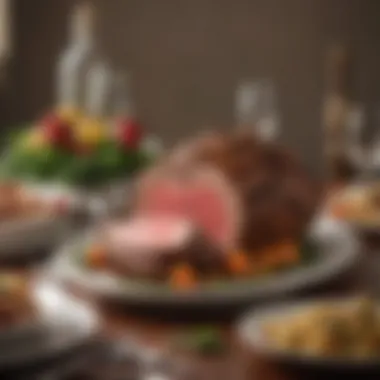
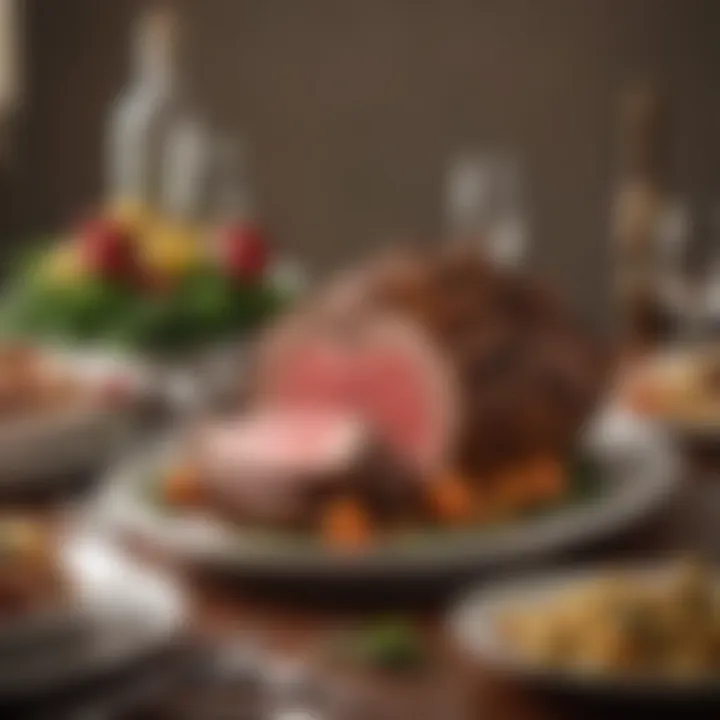
Points to consider about resting:
- Time: Rest for around 15-20 minutes for smaller cuts. Larger pieces may need longer—up to 30 minutes.
- Covering: (But not fully wrapping). Cover loosley with aluminum foil to retain warmth, as tightly covering retains too much moisture, resulting in steamed texture.
As highlighted, neglecting this step is one of the most common yet significant errors when handling prime rib. Patience during this phase will reward you with succulent slices of meat.
Proper Slicing Techniques
Slicing prime rib correctly allows you to appreciate its tenderness and showcases an appealing presentation. A good blade is essential; a long serrated knife or carving knife is recommended for clean cuts. Avoid using a dull knife—it will give uneven slices and tear at the meat, altering your overall dining experience.
Key slicing steps include:
- Direction: Always carve against the grain for the most tender pieces. Understanding grain direction requires some observation; the grain looks like straight muscle fibers.
- Consistency: Aim for even slices—about one-inch thick enhances both presentation and taste, ensuring each bite contains adequate flavor.
- Angles: Hold the knife at a slight angle, using smooth motions. Jagged edges diminish the quality of the presentation.
Accompaniments and Sauces
In any gourmet meal, the importance of accompaniments cannot be understated. Specifically for prime rib, the right side dishes and sauces enhance the overall experience. They complement the rich, buttery flavors of the roast and add elements of texture and color to your plate. Consideration of each component and its role in the dining experience elevates the meal from simple to refined.
Classic Side Dishes for Prime Rib
When serving a prime rib roast, choosing classic side dishes enriches the meal's ambiance. Here are several popular options that harmonize beautifully with the prime rib:
- Garlic Mashed Potatoes: Creamy and loaded with flavor, these mashed potatoes balance the richness of the roast.
- Roasted Brussels Sprouts: Caramelized edges add a touch of sweetness that pairs excellently with the meat.
- Yorkshire Pudding: This traditional British side provides a light and airy addition that soaks up any juices from the prime rib.
- Creamed Spinach: The contrast between the creaminess of the spinach and the textural elements of the beef makes each bite enjoyable.
- Steamed Asparagus: Simple yet effective, asparagus lends a fresh and earthy note, cutting through the heaviness of the meal.
These accompaniments not only complement the flavor profile but also provide a visually appealing spread when plated.
Recommended Sauces
Sauces offer another layer of depth to prime rib. They can enhance or contrast flavors, setting the mood for each mouthful:
- Au Jus: A classic sauce made from the drippings of the roast, it serves as a natural addition, preserving the prime rib's flavors.
- Horseradish Sauce: Its sharpness heightens the meat's taste. Consider preparing it with a sour cream base for balance.
- Red Wine Reduction Sauce: This sauce adds elegance with the boldness of red wine combining with savory herbs, making each bite memorable.
- Chimichurri: Fresh herbs really stand out. This sauce not only brightens but also adds an unexpected twist to the otherwise robust flavors of the meat.
Using quality ingredients is key for ultimate flavor satisfaction.
Storing Leftover Prime Rib
After enjoying a sumptuous prime rib roast, storing leftover meat may seem like an afterthought. However, proper storage is key to maintaining flavor and safety, ensuring you can savor every ounce of your culinary labor long after the initial meal. Understanding best practices in food storage allows you to minimize waste while maximizing enjoyment.
Proper Storage Techniques
To guarantee that leftover prime rib remains delicious, adhere to effective storage techniques. Freshness and texture can only be preserved through correct methods:
- Cool Down: Let the meat come down to room temperature. This should not take longer than two hours to prevent bacterial growth.
- Wrap Well: Wrap the leftover prime rib tightly in plastic wrap, foil, or butcher paper. Ensuring air cannot penetrate is essential.
- Use Airtight Containers: Place the wrapped ribs in an airtight container to provide further protection from moisture loss and odors in the fridge.
- Label and Date: Priting a label that states the date and type of meat helps to track freshness.
- Freeze for Longer Storage: If you won't eat the prime rib within three to four days, consider freezing it. Slice the meat into portions before placing it in a freezer-friendly airtight container or heavy-duty freezer bags.
This method keeps leftovers flavored while preventing freezer burn. When reheating frozen prime rib, it’s best to defrost overnight in the refrigerator before rekindling flavor on a low-heat setting.
Creative Uses for Leftovers
The possibilities with leftover prime rib go beyond simple reheating. Here are several creative options that elevate everyday meals:
- Prime Rib Sandwiches: Thinly slice the leftover meat for delectable sandwiches. Add toppings like arugula, horseradish sauce or creamy cheddar for contrast and flavor depth.
- Savory Tacos: Repurpose prime rib into flavorful tacos. Combine with ingredients such as grilled onions, cilantro, and lime for a robust twist.
- Fried Rice or Stir-Fry: Dice leftover prime rib and stir into upturned rice or vegetable stir-fry. The rich flavors ebb into the dish.
- Beef Stroganoff: Utilize leftover meat in a comforting beef stroganoff. Combine slices with mushrooms, onion, and sour cream over egg noodles.
- Soup or Stew: Use scraps in soups to enhance savoriness. Building a beef broth with the leftover parts brings depth—consider a hearty minestrone or classic beef stew.
By applying just a few innovative ideas, leftover prime rib can flourish far beyond its initial role as the centerpiece of a feast. Each of these options gives a chance to relive the prime rib experience.
Preserving leftover prime rib not only reduces waste but facilitates creativity in meal preparation, enhancing your culinary repertoire while maintaining a reduced environmental footprint.
The End
The conclusion of this article emphasizes the essential takeaways regarding the preparation and enjoyment of prime rib roast. It ties together the techniques and facts introduced in previous sections, providing clarity on how to successfully create an elegant meal.
Understanding that making a prime rib roast isn't merely about cooking meat, it's about introducing flavors and textures that offer satisfaction at the dining table. The article underscores the need for understanding every step, from selecting quality meat to ensuring proper cooking and serving methods. By doing so, readers are not only equipped with techniques but also with a deep appreciation of culinary craftsmanship.
In addition to the core cooking techniques, this conclusion reiterates the importance of certain habits:
- Selecting Prime Cuts: The benefits largely lie in the quality of the meat chosen. Recognizing how to identify the best cuts enhances the roast significantly.
- Mastering Cooking Techniques: Each method discussed in the article provides unique benefits. Knowing which one to apply is key.
- Resting and Slicing: Ensuring the meat is rested correctly and sliced adequately preserves the flavors and juiciness.
Recap of Key Steps and Considerations
In recap, here are the major steps and considerations for making an amazing prime rib:
- Understanding Prime Rib: Know what prime rib is and its different cuts, facilitating informed selections.
- Selecting the Right Prime Rib: Factor in grading, marbling, and individual preference.
- Preparation Techniques: Recall the importance of thawing, trimming, and seasoning the roast properly to elevate flavors.
- Cooking Methods: Assess which method suits your needs and tastes, be it roasting, sous vide, or grilling.
- Temperature and Timing: Pay attention to cooking temperatures and timing, which are critical to achieving your desired doneness.
- Resting and Slicing: Don't skip the resting period; it is crucial for flavor retention and texture.
- Accompaniments and Storage: Plan sides and sauces ahead, and develop proper storage techniques for leftovers, maximizing value.
This holistic approach provides the necessary platform to prepare a prime rib roast that is elegant, flavorful, and enjoyable. Each step taken reinforces good cooking habits that can carry over into other culinary endeavors.







